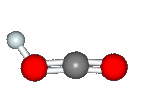
|
October 2003
 Protonated Carbon Dioxide |
|
HOCO+ is an example of an astromolecular ion. Its detection was reported in 1981 by Thaddeus, Guélin, and Linke. HOCO+ consists of CO2 with H+ attached to one of the oxygen atoms, hence the designation "protonated carbon dioxide." A number of charged astromolecules are protonated forms of common neutral species and are natural precursors for them. A common reaction in the interstellar medium involves capture of a free electron by a cationic species, known as dissociative recombination: HOCO+ + e- → CO2 + H Interestingly, HOCO+ was detected in the interstellar medium before CO2. Carbon dioxide is harder to detect because its ground electronic state has a zero dipole moment, which results in only weak IR and millimeter features. HOCO+ is a quasilinear molecular ion, a nearly symmetric top, which is isolectronic with HNCO HNCO (isocyanic acid) and HOCN) cyanic acid. |

|
|